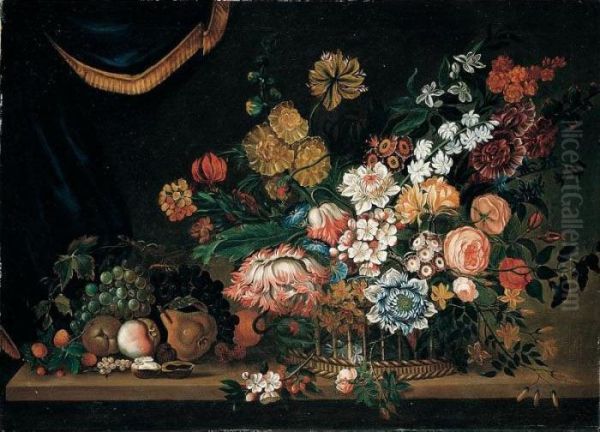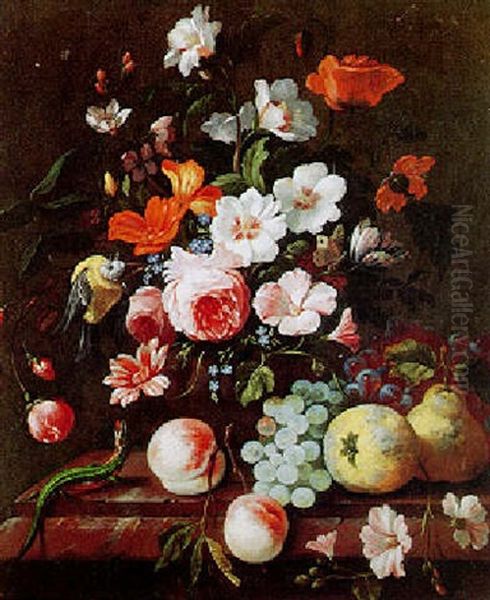Pieter Hardime, an artist whose life and work bridged the late 17th and mid-18th centuries, holds a notable place in the annals of Dutch and Flemish art. Though perhaps not as universally recognized today as some of his contemporaries, his skill in depicting the lush beauty of flowers and fruits earned him considerable acclaim during his lifetime. His paintings are characterized by their vibrant coloration, meticulous detail, and harmonious compositions, reflecting the enduring appeal of still life painting in the Low Countries.
Early Life and Artistic Beginnings in Antwerp
Born in Antwerp in 1677, a city then renowned as a vibrant hub of artistic activity within the Spanish Netherlands, Pieter Hardime was immersed in a rich cultural environment from a young age. He was the younger brother of Simon Hardime (1672-1737), who was also a painter, specializing in similar subject matter. It is highly probable that Pieter received his initial artistic training from, or alongside, his elder brother. However, art historical accounts consistently suggest that Pieter's talents eventually surpassed those of Simon. Critics and connoisseurs of the time, and subsequently, have noted Pieter's superior handling of color, the elegance of his arrangements, and the overall aesthetic appeal of his canvases. This distinction highlights a dedication to refining his craft and developing a personal style that, while rooted in the established traditions of Flemish still life, possessed a unique vibrancy.
Antwerp, during this period, was still feeling the artistic legacy of masters like Jan Brueghel the Elder and Daniel Seghers, who had elevated floral painting to a high art form. The demand for such works was strong, both for their decorative qualities and their often-underlying symbolic meanings. It was within this fertile artistic ground that Pieter Hardime honed his skills, preparing him for a successful career that would largely unfold in the Dutch Republic.
A Flourishing Career in The Hague

While his origins were Flemish, Pieter Hardime spent a significant portion of his professional life in The Hague, a prominent city in the Dutch Republic. This move was not uncommon for artists from the Southern Netherlands, as the Dutch Republic offered a thriving art market and opportunities for patronage. Hardime established himself as a respected painter, particularly sought after for his exquisite still lifes of flowers and fruits. His reputation grew, leading to important commissions and collaborations.
One of the most significant projects Hardime undertook was for the Abbey of St. Bernard, near his native Antwerp. This connection was perhaps facilitated by his marriage to the sister of the Abbot of this Cistercian monastery. For the Abbey, Hardime painted a series of four large canvases representing "The Four Seasons." Each painting in this series was distinguished by the specific inclusion of flowers, plants, and fruits appropriate to the depicted season, showcasing not only his artistic skill but also his botanical knowledge. Such allegorical representations of the seasons were popular, allowing artists to display their virtuosity in rendering diverse natural elements.
In The Hague, Hardime also engaged in decorative projects, often in collaboration with other artists. He is known to have worked with the Terwesten family of painters, most likely Augustinus Terwesten (1649–1711) or his younger brother Mattheus Terwesten (1670–1757), who were influential figures in the artistic life of the city. Together, they adorned rooms in prestigious residences, including the "Huis Honselaarsdijk," one of_ the palaces of the Princes of Orange, and possibly other grand houses such as the Wassenaer family's residence. In these collaborations, Hardime's contribution typically involved the painting of floral and fruit elements, integrating his specialized skills into larger decorative schemes. These works would have added an element of opulence and natural beauty to the interiors they graced. His ability to work on a large scale, as evidenced by the "Four Seasons" and these decorative projects, demonstrates a versatility beyond smaller easel paintings.
Beyond The Hague, Hardime is also recorded as having undertaken short working stays in other parts of Holland and even in Prussia, indicating that his reputation extended beyond his primary place of residence.
Artistic Style, Technique, and Representative Works

Pieter Hardime's artistic output is primarily centered on still life paintings, with a particular emphasis on flowers and fruits. His style is marked by a refined sense of color, often employing a rich and vibrant palette that brought his subjects to life. He possessed a keen eye for detail, rendering the delicate textures of petals, the sheen of fruit, and the subtle interplay of light and shadow with considerable skill. His compositions were generally well-balanced and elegant, often featuring abundant bouquets in ornate vases or arrangements of fruit in landscape settings or on ledges.
Compared to his brother Simon, Pieter is consistently described as having a more sophisticated approach to composition and a more beautiful application of color. While Simon was a capable painter, Pieter's works are often seen as possessing a greater degree of finesse and artistic invention. This suggests a continuous effort on Pieter's part to elevate his work beyond mere representation, aiming for a harmonious and aesthetically pleasing whole.
One of his documented representative works is a painting titled "Flowers and Fruits," created in 1697. This relatively early piece, measuring 38 x 30 cm, already indicates his burgeoning talent in the genre. The aforementioned "Four Seasons" series for St. Bernard's Abbey would undoubtedly be considered among his major achievements, showcasing his ability to handle complex allegorical themes on a grand scale. While specific details of many individual works can be elusive, his oeuvre generally aligns with the prevailing tastes of the late Baroque period, which favored opulence, naturalism, and often, a degree of symbolic content. Flower paintings, for instance, could carry connotations of transience (vanitas), the beauty of creation, or specific virtues associated with different blooms.
Works by Pieter Hardime are held in various collections. For instance, two of his flower pieces are noted as being in the municipal museum of Breda. The presence of his paintings in such collections today allows for continued appreciation and study of his contribution to still life painting.
Contemporaries and the Artistic Milieu
Pieter Hardime worked during a vibrant period in Dutch and Flemish art, albeit one that is often seen as a transition from the Golden Age of the 17th century. He was a contemporary of several notable artists, and his career unfolded within a competitive yet interconnected artistic community.
His most immediate artistic relation was, of course, his brother Simon Hardime. While they shared a specialization, Pieter's ascendancy in terms of skill likely created a dynamic of familial comparison, if not direct rivalry.
In The Hague, his collaboration with the Terwesten brothers (Augustinus and Mattheus) places him within an important circle of decorative painters. The Terwestens were instrumental in the founding of The Hague's drawing academy, the Haagsche Teekenacademie, indicating their central role in the city's artistic life.
Other prominent flower painters active during or overlapping with Hardime's career include Jan van Huysum (1682–1749) and Rachel Ruysch (1664–1750) in the Northern Netherlands. These artists brought Dutch flower painting to an unparalleled level of refinement and popularity, and Hardime's work can be seen as part of this broader flourishing of the genre. While perhaps not reaching the same zenith of fame as Van Huysum or Ruysch, Hardime was a significant contributor to this tradition.
In the Southern Netherlands, the legacy of earlier Flemish masters like Daniel Seghers (1590–1661) and Jan Philips van Thielen (1618–1667) continued to influence flower painters. Contemporaries in the Flemish tradition included artists like Gaspar Peeter Verbruggen the Younger (1664–1730), who also specialized in opulent floral still lifes.
The broader artistic landscape included painters specializing in various genres. For example, Daniel van den Hurk (1636-1704), mentioned in some historical accounts, was known for his portraits in the style of Caspar Netscher (1639–1684). While their subject matter differed, they were part of the same artistic ecosystem. Other still life painters of note from the general period, whose work contributed to the rich tapestry of the genre, include Abraham Mignon (1640-1679), known for his detailed forest floor still lifes and flower pieces, and Jan Weenix (1642-1719), celebrated for his hunting still lifes (pronkstilleven) which often included fruit and flowers. The work of Melchior d'Hondecoeter (1636-1695), famous for his depictions of exotic birds in park-like settings, also shares the decorative appeal found in Hardime's larger commissions. Even earlier masters like Jan Davidsz. de Heem (1606–1684) cast a long shadow, having been a pivotal figure in the development of lavish still life painting in both Antwerp and the Dutch Republic.
The art market of the time was diverse, with collectors seeking various types of paintings. Hardime's specialization in an established and popular genre ensured a steady demand for his work.
Later Years and Legacy
In the later stages of his life, Pieter Hardime relocated from The Hague to Dordrecht (often referred to as "Dort" in older texts), another historic Dutch city with its own artistic traditions. He passed away in Dordrecht in 1758, bringing to a close a long and productive career that spanned over six decades.
Pieter Hardime's legacy lies in his contribution to the rich tradition of floral and fruit painting in the Low Countries. He successfully navigated the artistic worlds of both Antwerp and The Hague, adapting his skills to both easel painting and large-scale decorative commissions. His works are admired for their aesthetic beauty, technical proficiency, and the vibrant depiction of nature's bounty. While he may be overshadowed in modern art historical narratives by a few of the era's giants, his paintings remain a testament to the enduring appeal of still life and the high level of artistry achieved by painters like him during the late Baroque period. His ability to create works that were "more beautiful in color and better arranged" than those of his brother Simon speaks to a dedicated pursuit of artistic excellence that defines his contribution to art history.
His paintings continue to be appreciated in public and private collections, offering a window into the tastes and artistic achievements of the 18th century. As an art historian, one recognizes Pieter Hardime as a skilled practitioner who upheld and enriched a significant genre, leaving behind a body of work that continues to delight the eye.